CAT 1992 Question Paper with Answer Key PDF is available for download. CAT 1992 Question Paper was a set of 150 questions. A total of 120 minutes or 2 hours were allotted to complete the 150 questions. All the questions were distributed across 4 sections I e. Verbal Ability, Data Interpretation, Problem Solving/ Quant, and Reading Comprehension
Candidates preparing for CAT 2025 can download the CAT 1992 question paper with the solution PDF to get a better idea about the type of questions asked in the paper and their difficulty level.
Also Check:
CAT 1992 Question Paper with Solution PDF
| CAT 1992 Question Paper with Answer Key | Download PDF | Check Solutions |

1. Amount of published information available varies widely by industry.
A. Unfortunately for the researcher, many industries do not meet these criteria, and there may be little published information available.
B. Generally, the problem the researcher will face in using published data for analysing an economically meaningful industry is that they are too broad or too arranged to fit the industry.
C. However, it is always possible to gain some important information about an industry from published sources and these sources should be aggressively pursued.
D. Larger the industry, the older it is, and the slower the rate of technological change, better is the available published information.
6. If a researcher starts searching for data with this reality in mind, the uselessness of broad data will be better recognised and the tendency to give up will be avoided.
View Solution
The main source of power in industrial undertaking is electricity.
A. Electricity from water also requires enormous river valley projects involving huge expenditure.
B. In contrast, electricity from atomic power stations will result in a tremendous saving in expenditure.
C. Besides, the mineral resources of the world required for generation of electricity are being rapidly depleted.
D. But the production of electricity needs huge quantities of coal.
6. The installation of atomic plants will help in meeting the shortage of these resources.
View Solution
Intensity of competition in an industry is neither a matter of coincidence nor bad luck.
A. The collective strength of these forces determines the ultimate profit potential in the industry where profit potential is measured in terms of long run returns on invested capital.
B. Rather, competition in an industry is rooted in its underlying economic structure and goes well beyond the behaviour of current competitors.
C. Not all industries have the same potential.
D. The state of competition in an industry depends on five basic competitive forces.
6. They differ fundamentally in their ultimate profit potential as the collective strength of the forces differ.
View Solution
The general enemy of mankind, as people have discovered, is not science, but war.
A. It is found that there is peace, science is constructive; when there is war science is perverted to destructive ends.
B. Science merely reflects the social forces by which it is surrounded.
C. Until now, they have brought us to the doorstep of doom.
D. The weapon which science gives us do not necessarily create war, these make war increasingly more terrible.
6. Our main problem, therefore, is not to curb science, but to stop war, to substitute law for force and international governments for anarchy in the relations between nations.
View Solution
It will be foolish to deny that the countryside has many attractions to offer.
A. One soon gets tired of the same old scenes and creatures day in and day out.
B. But there is another side of the picture.
C. The honesty and frankness of the country-folk, too, is a refreshing change from the dishonesty and selfishness we find in so many urban people.
D. There is the lovely scenery, the interesting and varied wildlife, the long rambles through the woods and fields and the clean, healthy air.
6. The loneliness and monotony in the countryside soon begin to make themselves felt and we long for the familiar sidewalks and street corners of the town.
View Solution
1. A welfare state in the attainment of its objective must avoid coercion and violence.
A. But communism implies the loss of freedom of expression and action and introduces a regimentation of life.
B. Communism implies the loss of freedom of expression and action and introduces a regimentation of life.
C. There are all serious disadvantages which perhaps outweigh the economic gains.
D. Communism aims at the welfare state and perhaps the completest form of the welfare state in most respects.
6. A true welfare state can develop only by following the path of peace and democracy.
View Solution
1. Human experience tends to show that the more we mix with a man, the more we come to dislike him.
A. When the acquaintance with him ripens into intimacy, we are likely to become very keenly aware of his defects and imperfections.
B. In the beginning, we may feel greatly attracted by someone because of certain qualities that we find in him.
C. But on closer acquaintance we will begin to perceive his faults and shortcomings.
D. The truth is that nobody is free from faults and weaknesses.
6. But while a man makes a show of his strong points and his good qualities, he generally tries to conceal or cover his faults and defects.
View Solution
Arrange the sentences to form a coherent paragraph:
A. It is turning off the tap.
B. And with no consensus of the exit policy, the government is damned if it supports loss making units and damned if it doesn’t.
C. The private sector did the same in the past because securing legal sanction for closure was virtually impossible.
D. After years of funding the losses of public sector companies, the government is doing the unthinkable.
View Solution
Arrange the sentences to form a coherent paragraph:
A. Trade protocols were signed, the dollar as the medium of exchange was ignored, trade was denominated in rupees and the exchange rate between the two countries was to be fixed outside the ambit of free markets.
B. A young India, some years after independence fashioning her foreign policy of nonalignment, found it prudent to stay close to the former Soviet Union.
C. Once upon a time there was a super power named Soviet Union that attracted nations apprehensive of the global aspirations of the other superpower, the U.S.A.
D. One way of doing this was to evolve a bilateral relationship in trade that could be called upon to provide a buffer against the arm-twisting by the U.S.A.
View Solution
Arrange the sentences to form a coherent paragraph:
A. I had heard that sort of thing before.
B. He said that his generation was the first to believe that it had no future.
C. A young American made earthling stopped by my house the other day to talk about some book of mine he had read.
D. He was the son of a Boston man who had died an alcoholic vagrant.
View Solution
Arrange the sentences to form a coherent paragraph:
A. This is probably one of the reasons why the number of women and men remain roughly equal in most societies.
B. Fortunately or unfortunately, individual couples cannot really be concerned about this overall 'error'.
C. Population growth can then be considered the error of this central process.
D. Purely at the human level, it appears that most couples like to have at least one living daughter and one living son when they are in the middle ages.
View Solution
Arrange the sentences to form a coherent paragraph:
A. Against this background, the current target of 12.8 percent does not seem that high a figure.
B. A better vantage point to evaluate the 12.8 percent target for export growth is our performance in the ‘golden years’ between 1986–87 and 1990–91, during which time exports in dollar terms increased by 17.1 percent.
C. In fact, the rate of growth would have to increase still further if we were to achieve the eighth plan target of export growth in value terms of 13.6 percent per annum.
D. In 1990–91, the year of the Gulf War, exports went up by 9 percent.
View Solution
Arrange the sentences to form a coherent paragraph:
A. Their growing costs and a growing economy must be reckoned with realistically.
B. Central programmes persist and in some cases grow.
C. As demand expands, programmes expand.
D. It is extremely difficult to curtail them.
View Solution
Arrange the sentences to form a coherent paragraph:
A. It was never denied and seemed to be integrated into the city life.
B. The poverty was there right in the open in all the streets.
C. But, somehow it did not depress me as much as I had feared.
D. Indian society is associated with great poverty, and indeed I saw a lot of poverty in Bombay.
View Solution
Arrange the sentences to form a coherent paragraph:
A. This has been going on now for nearly 200 years.
B. They haven’t even been noticed much by central, state, or local governments, no matter how insolent or blasphemous or treasonous those writers may be.
C. But writers of novels, plays, short stories or poems have never been hurt or hampered much.
D. Journalists and teachers are often bullied or fired in my country for saying this or that.
View Solution
A. All boys are good.
B. Some girls are bad.
C. Good people are educated.
D. Boys are educated.
E. Ram is an educated boy.
F. Lata is an educated girl.
View Solution
A. All who are sincere are graduates.
B. Some graduates are not sincere.
C. All who are sincere are dull.
D. All graduates are dull.
E. Some who are dull are graduates.
F. No one who is dull is sincere.
View Solution
A. Sham won a lottery.
B. Sham lost in a chess game.
C. Sham is not intelligent.
D. One need not be intelligent to win a lottery.
E. One need not be intelligent to win a chess game.
F. Sham plays chess.
View Solution
A. Good managers are intuitive.
B. Some managers are women.
C. Supriya is a good manager.
D. Supriya is a woman.
E. Some women are intuitive.
F. Supriya is intuitive.
View Solution
A. Some college athletes are professionals.
B. No college athlete is a professional.
C. Some professionals are well paid.
D. All professionals are well paid.
E. All well–paid persons are professionals.
F. No well–paid person is a college athlete.
View Solution
A. Some intolerant are poor–thinkers.
B. Some poor–thinker is intolerant.
C. All people with high ideals are intolerant.
D. No poor thinker is intolerant.
E. No poor thinker has high ideals.
F. Some people with high ideals are not poor thinkers.
View Solution
A. All engineers can sing.
B. No music lover can sing.
C. All who can sing are music lovers.
D. All music lovers can sing.
E. Some who can sing are engineers.
F. All engineers are music lovers.
View Solution
A. Some well-dressed people are sociable.
B. All sociable people are well-dressed.
C. Some well-dressed people are dull.
D. No dull person is well-dressed.
E. Some sociable people are dull.
F. Some dull ones are well-dressed.
View Solution
A. Iran and Iraq are members of the UN.
B. Iran and Iraq are not friends.
C. Iran and Iraq are neighbours.
D. Some UN members are friends.
E. Not all members of the UN are friends.
F. All neighbours are not friends.
View Solution
If an islander asks, "Do I belong to the No type", which of the following is correct?
View Solution
Ram and Laxman are brothers from the Island. Laxman asks you, "Is at least one of us brothers of type 'No'?" You can conclude that:
View Solution
You are approached by one of the islanders and asked, "Am I of type 'Yes'?" You can infer that:
View Solution
Each of these questions has four items. You are required to select that item which does not belong to the group.
View Solution
Each of these questions has four items. You are required to select that item which does not belong to the group.
View Solution
Each of these questions has four items. You are required to select that item which does not belong to the group.
View Solution
Each of these questions has four items. You are required to select that item which does not belong to the group.
View Solution
Each of these questions has four items. You are required to select that item which does not belong to the group.
View Solution
Each of these questions has four items. You are required to select that item which does not belong to the group.
View Solution
Each of these questions has four items. You are required to select that item which does not belong to the group.
View Solution
Each of three friends knows whether the other two have passed or failed in an examination, but does not know his own result. The teacher comes and says, "At least one has failed." If all three still do not know their own results, which of the following is true?
View Solution
SYMPHONY : COMPOSER
View Solution
TREE : TRUNK
View Solution
CIRCLE : ARC
View Solution
COW : HERD
View Solution
WOOL : ACRYLIC
View Solution
DOCTOR : DISEASE
View Solution
BIRD : ORNITHOLOGY
View Solution
FOOD : HUNGER
View Solution
SPEAR : DART
View Solution
BUILDING : BRICK
View Solution
Pakistan was the team / whom most people thought / would win the World Cup / held in 1987.
View Solution
When you turn to your right, / you will find a big house / with a beautiful garden on the front side of it / and that is my residence.
View Solution
I have been postponing calling / on my friend in the hospital, / but I am planning / I would go there tomorrow.
View Solution
I wondered who could be calling me at midnight / and when I took the phone / I found it was not other / than my fiancé from Paris.
View Solution
I want you to take the first bus / and to go to the Bank / and remit this cheque and then / come back straight here.
View Solution
The discovery of sulphonamides
View Solution
The current medical practice as carried out in America benefits mostly the
View Solution
In some European countries anti-diabetic drugs are far more commonly used than others because
View Solution
Which of the following statements is false?
View Solution
Which of the following measures if undertaken under ‘Care rather than Cure’ movement could prove to be controversial?
View Solution
The outcomes movement could make a significant impact on medical practice if only
View Solution
Modern cure are known to be expensive because
View Solution
The main objection to ‘care rather cure’ approach is that it
View Solution
Smith's attitude to the virtues of self-interest can be best described as
View Solution
According to Adam Smith
View Solution
All of the following are reasons for market failure except:
View Solution
Adam Smith is most likely to agree with the statement:
View Solution
Which of the following situations is not an instance of market failure?
View Solution
The 'free rider' problem results in the need for all of the following except
View Solution
Based on the passage, competitions will directly affect all of the following except:
View Solution
We can conclude from the passage that:
View Solution
Based on the passage, we could say that Adam Smith would not support
View Solution
All the following characteristics of the modern world are used as arguments for government intervention except:
View Solution
Based on the passage, the following can be inferred, except which of the following?
View Solution
The most serious problem of modern government is that they
View Solution
An atmospheric jet stream is
View Solution
Detailed studies of atmospheric streams have been made over
View Solution
The atmospheric jet stream consists of
View Solution
According to present knowledge, jet streams are caused when
View Solution
Jet streams affect air-traffic by
I. delaying flights.
II. Increased fuel consumption.
III. Their propensity to cause accidents.
IV. Damaging the air frame.
View Solution
The summer monsoon over India is caused by
View Solution
The result of the Subtropical Jet Stream is
View Solution
The areas most prone to salinization are
View Solution
The most appropriate title to this passage is
View Solution
Natural fertility exhausts most quickly in
View Solution
The factor that can restore fertility to the soil not mentioned in the passage is
View Solution
Crop rotation helps to
I. increase the farmer’s seasonal income.
II. preserve soil condition.
III. desalinate the soil.
IV. destroy pests.
View Solution
One of the characteristics of agricultural land in Nile basin is
View Solution
Plants with nodules on their roots are known as
View Solution
The author’s attitude towards the application of scientism to the social sciences is best described as one of
View Solution
According to the author, causes and effects in the social world are
View Solution
Which of the following statements about scientism is best supported by the passage?
View Solution
As is used in the passage, the term ‘scientism’ can best be defined as
View Solution
In the passage, the author is most concerned with doing which of the following?
View Solution
The passage is most likely directed towards an audience of
View Solution
Which of the following best describes the main subject of the passage?
View Solution
The passage indicates that a single cycle of which of the following motions is completed in the shortest period of time?
View Solution
Which of the following techniques does the author use in order to make the descriptions of motion clear?
I. Comparison with familiar objects.
II. Reference of geometric forms.
III. Allusions to the works of other authors.
View Solution
The passage has most probably been taken from a book on
View Solution
Mesenteries are
View Solution
Through peri-vascular spaces exchange takes place between
View Solution
The connective tissue in which fat is stored is called
View Solution
The connective tissues originate in the
View Solution
Some instances of connective tissues are
I. Cartilage
II. Stroma
III. Lipid
IV. Synovia
View Solution
The tissue which enables smooth gliding movements of neighbouring surfaces is
View Solution
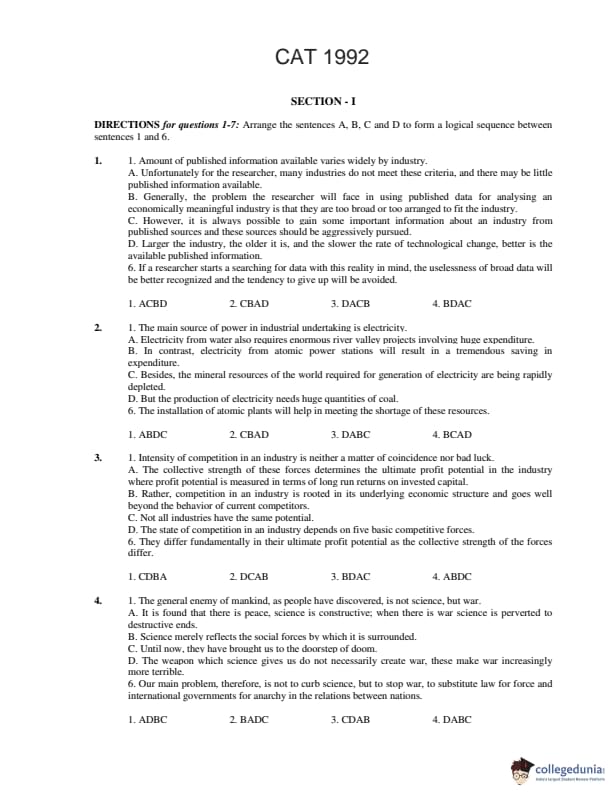
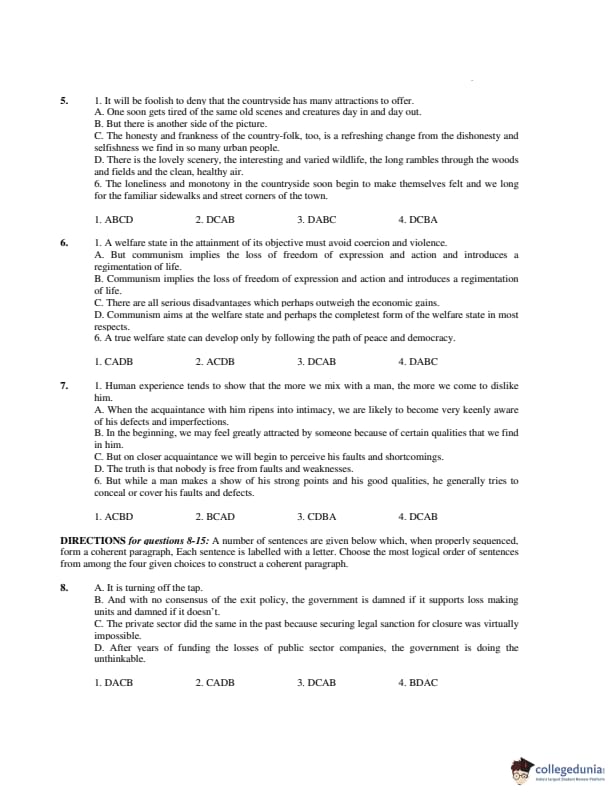
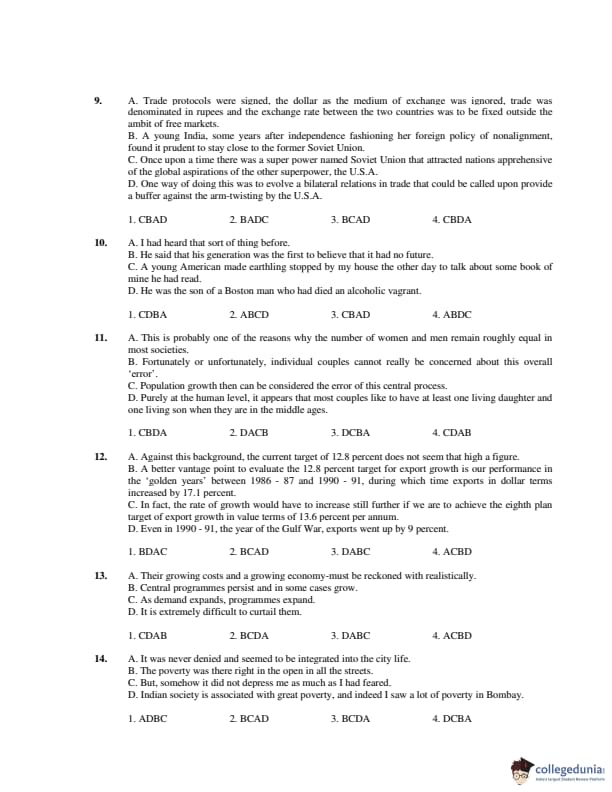
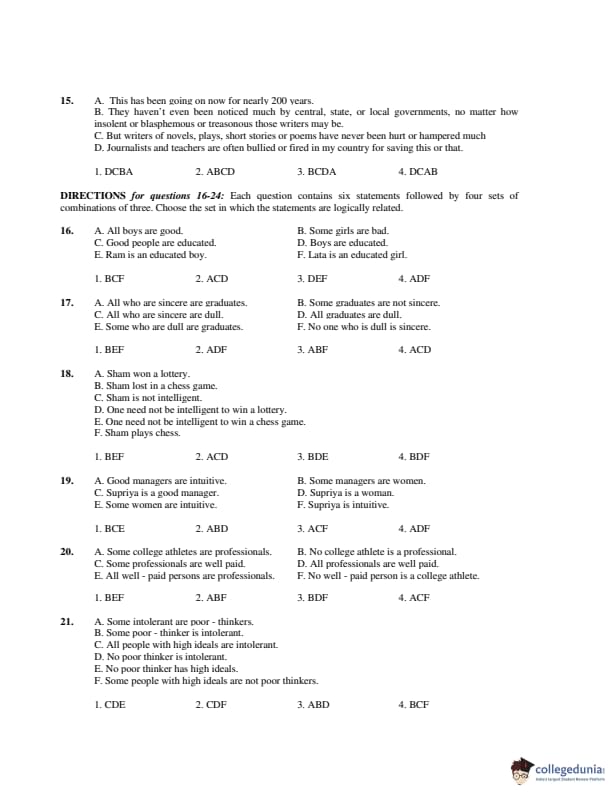
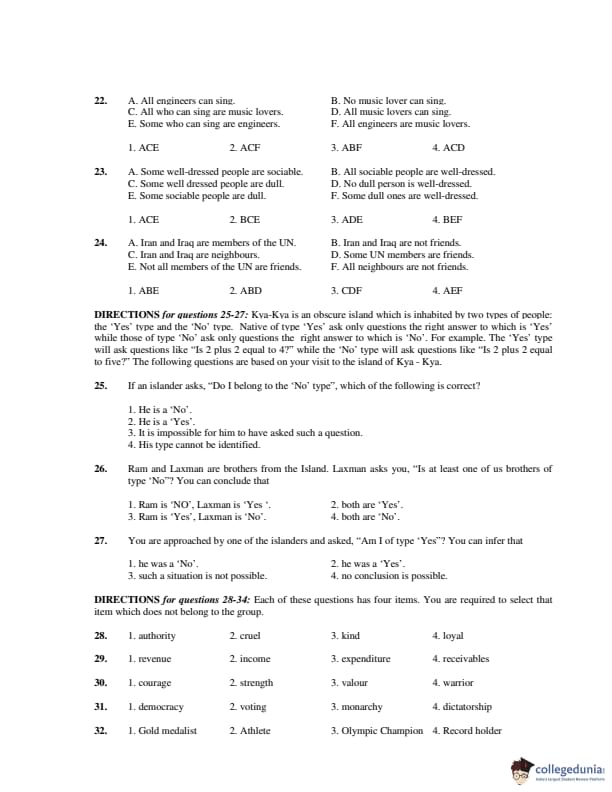
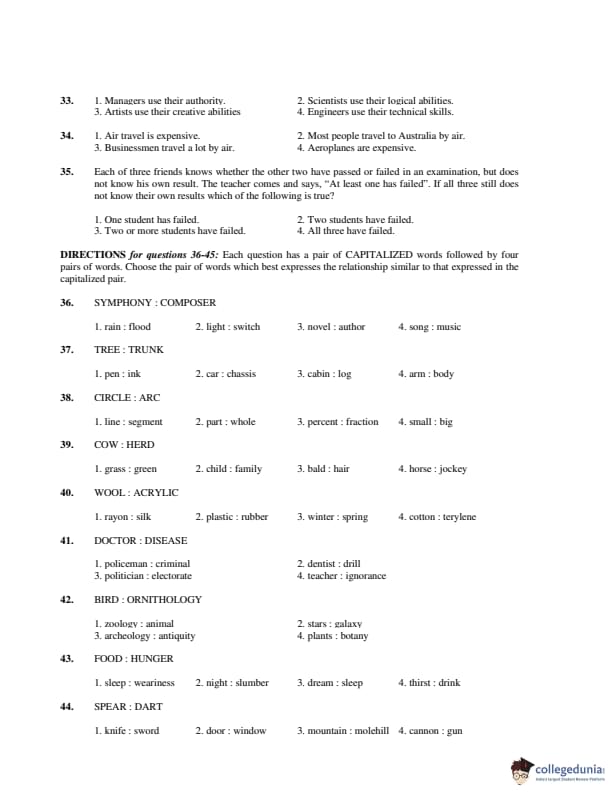
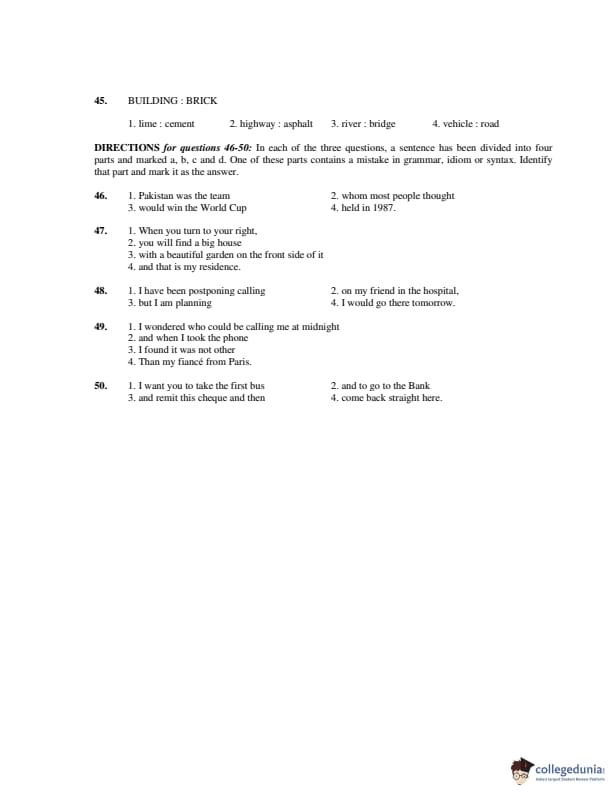

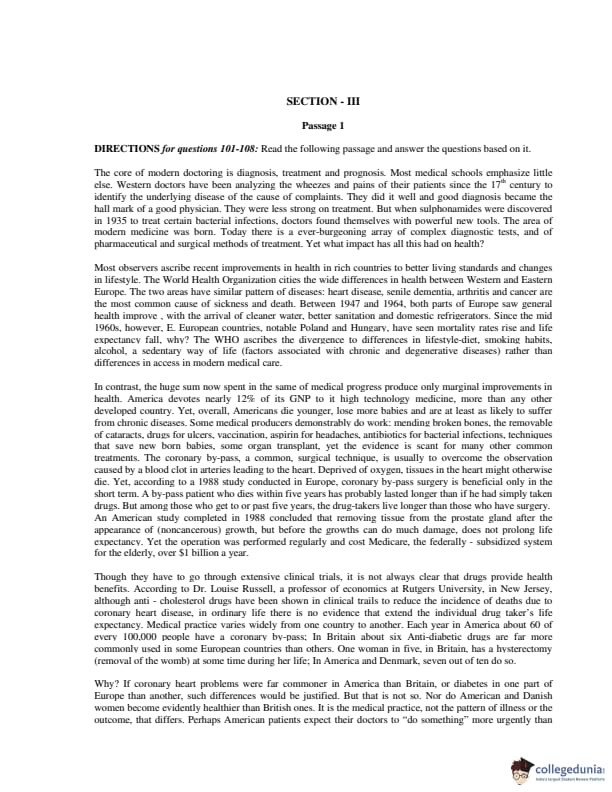
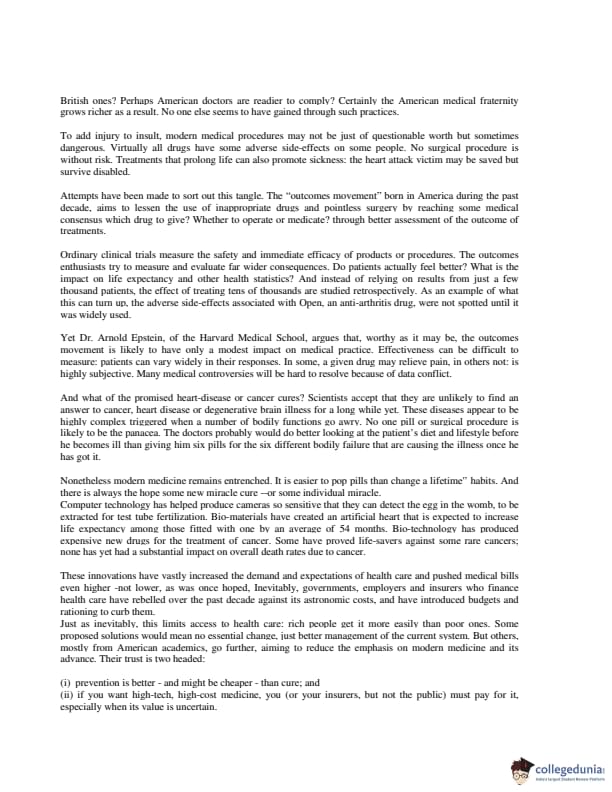
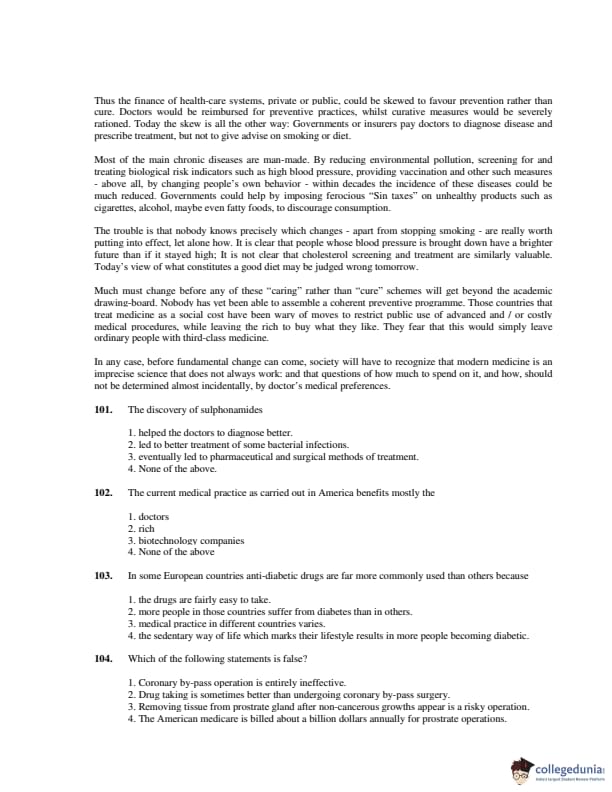

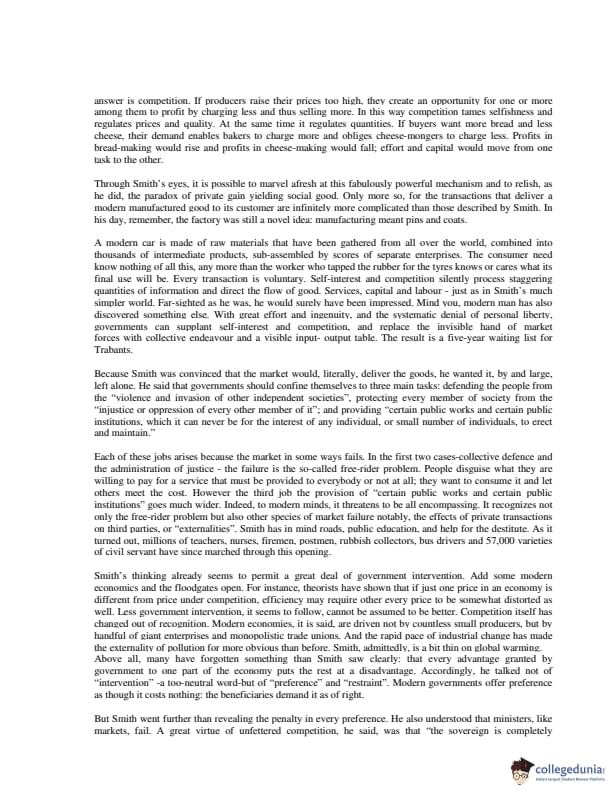
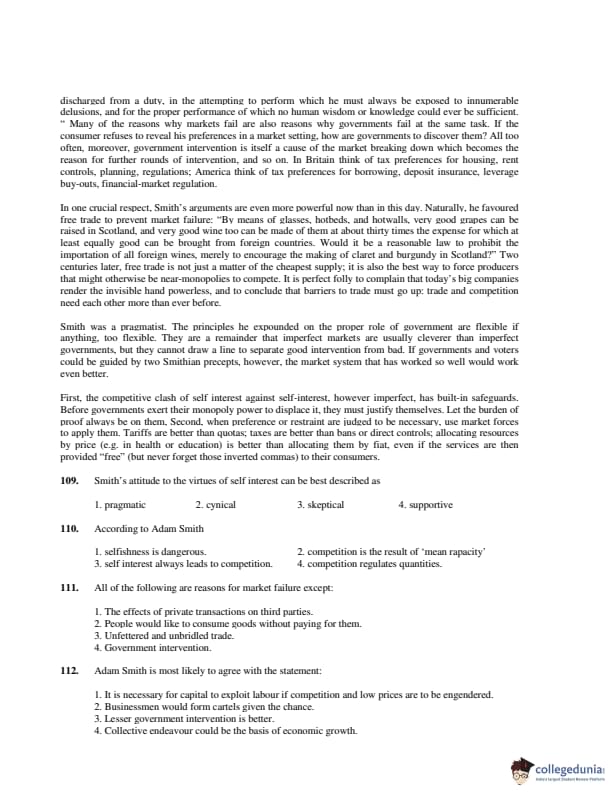
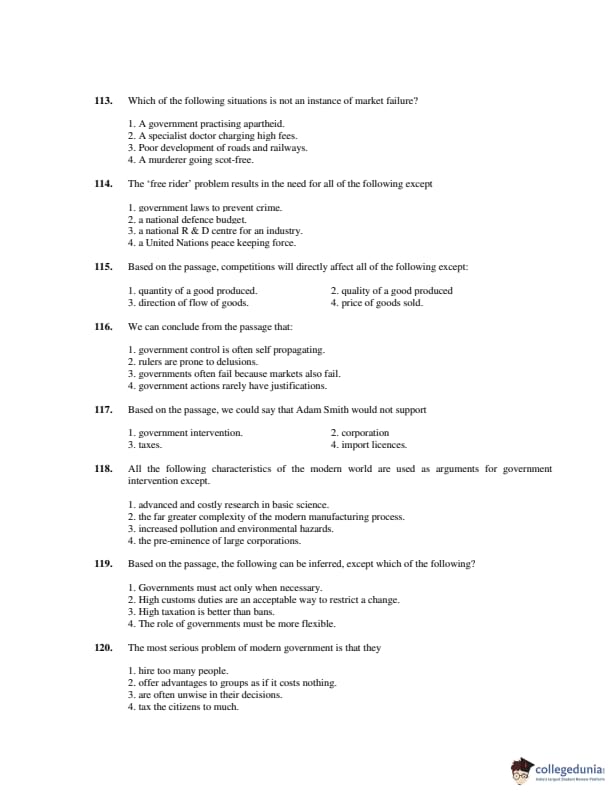
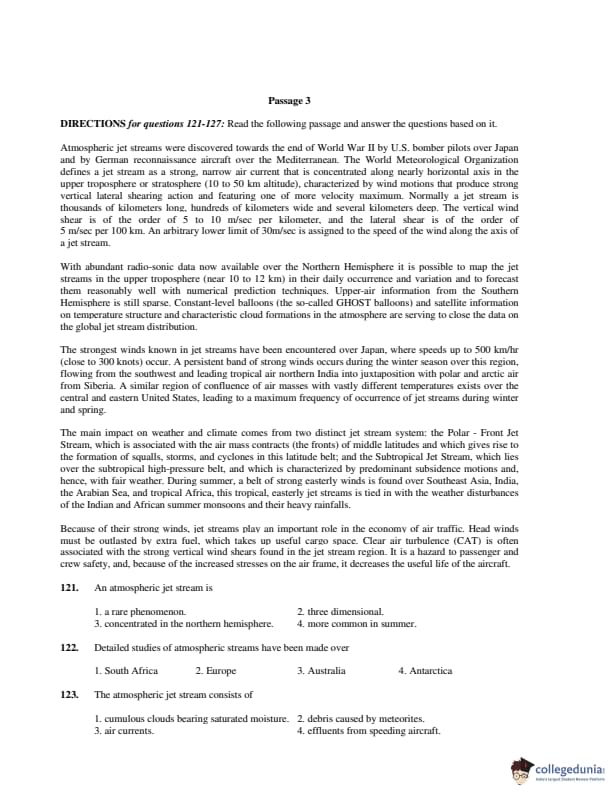
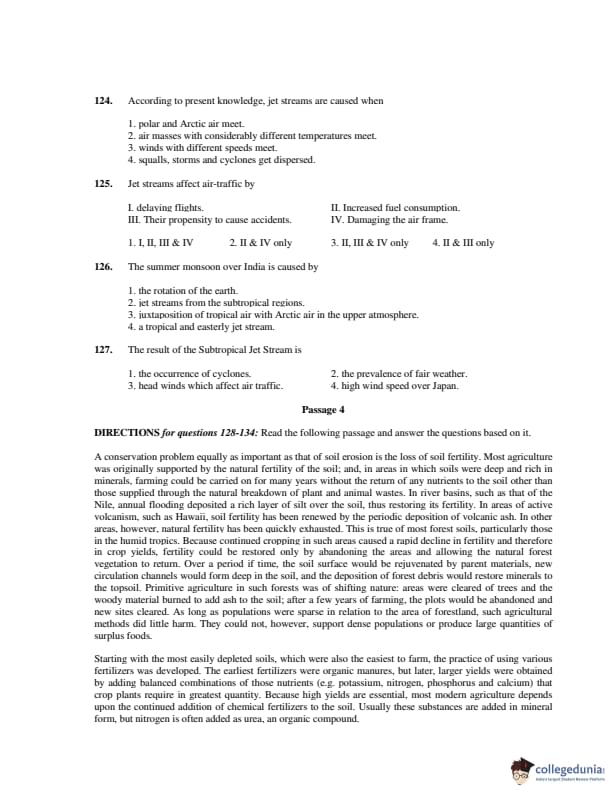
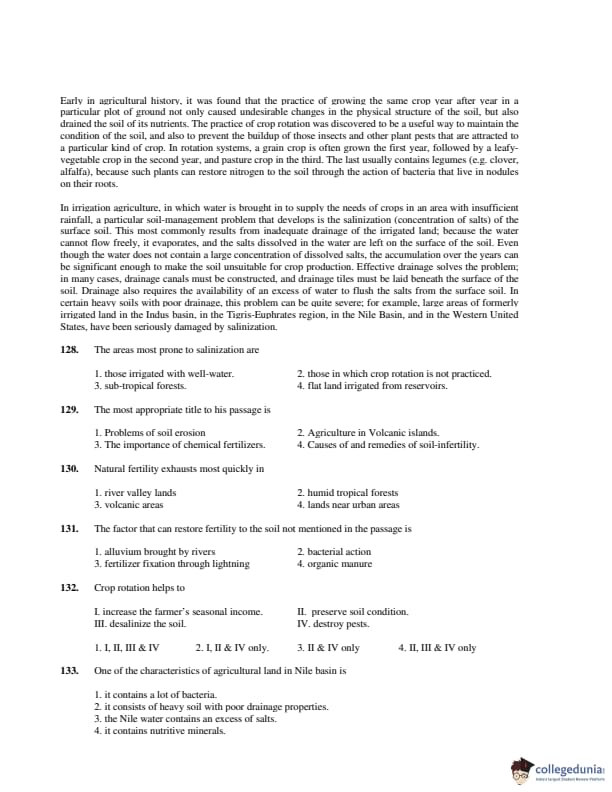
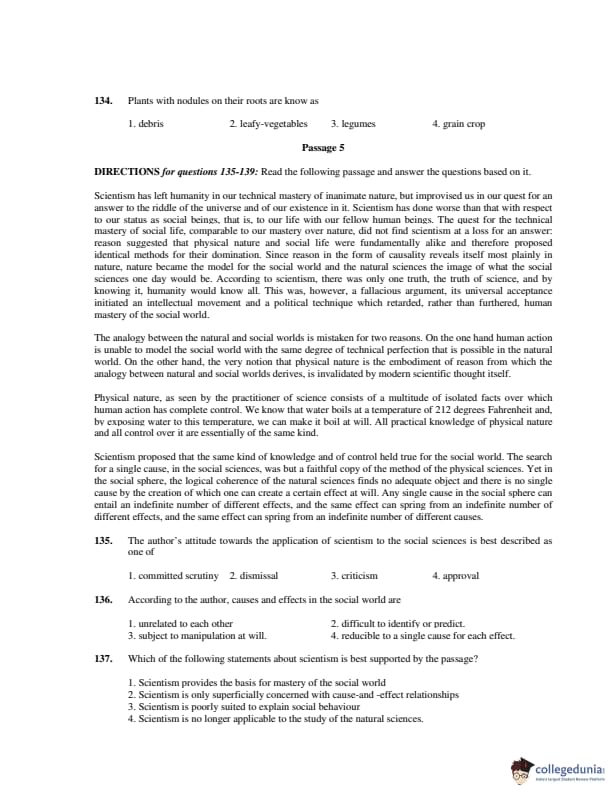
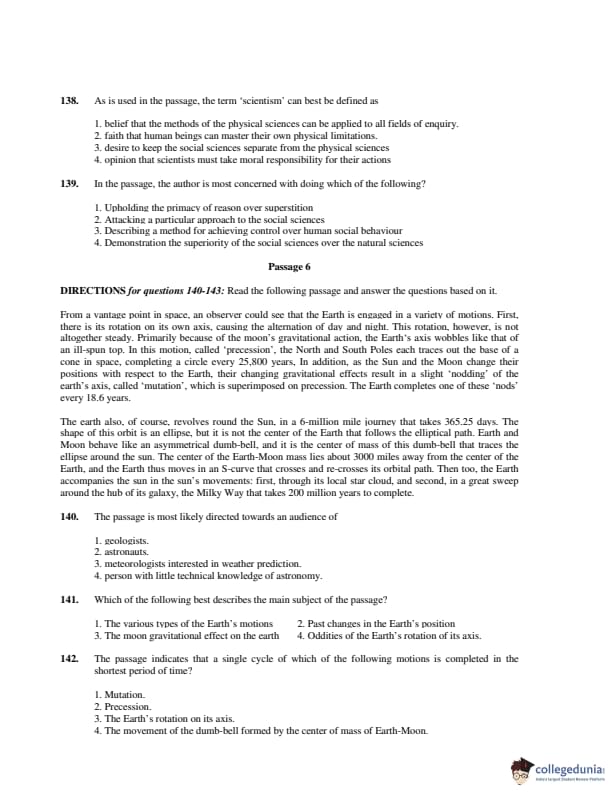
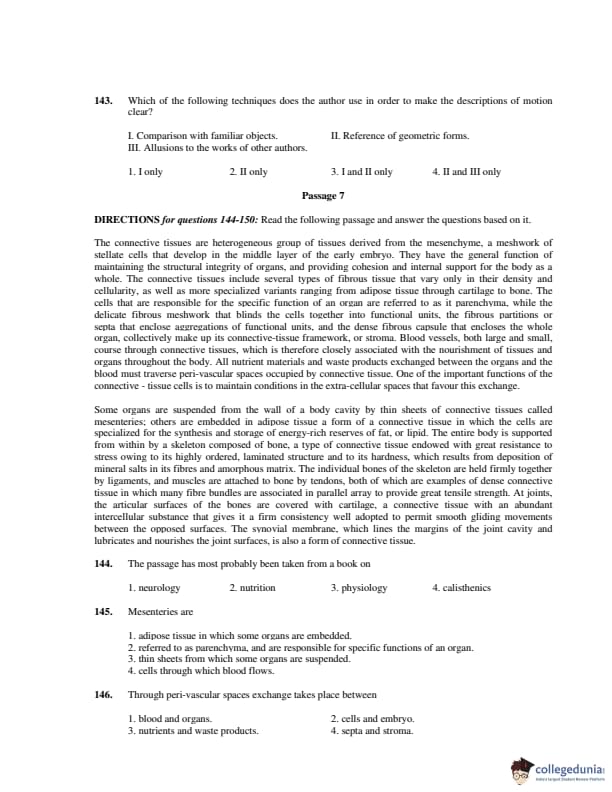
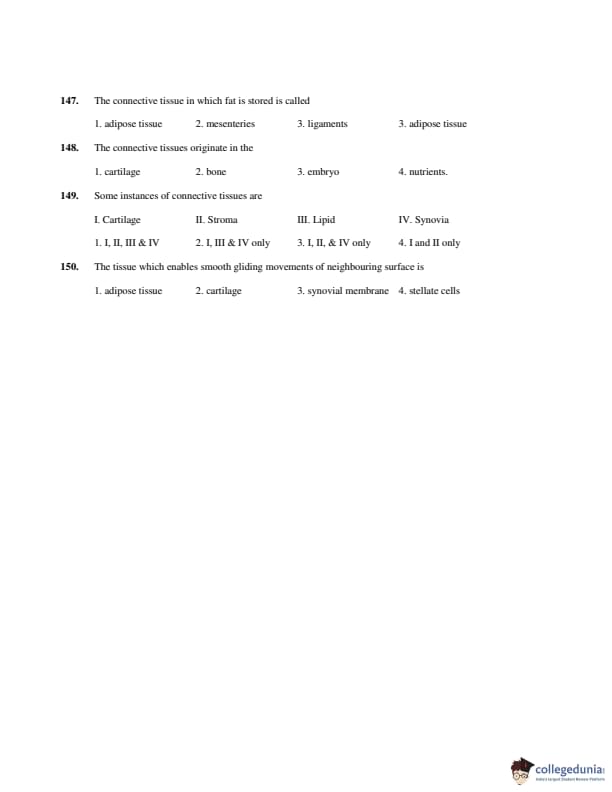

CAT Previous Year Question Papers
Candidates preparing for CAT exam are recommended to solve CAT previous year question papers to improve their time management and problem-solving skills.
| CAT 2022 Question Papers | CAT 2021 Question Papers | CAT 2020 Question Papers |
| CAT 2019 Question Papers | CAT 2018 Question Papers | CAT 2017 Question Papers |




Comments